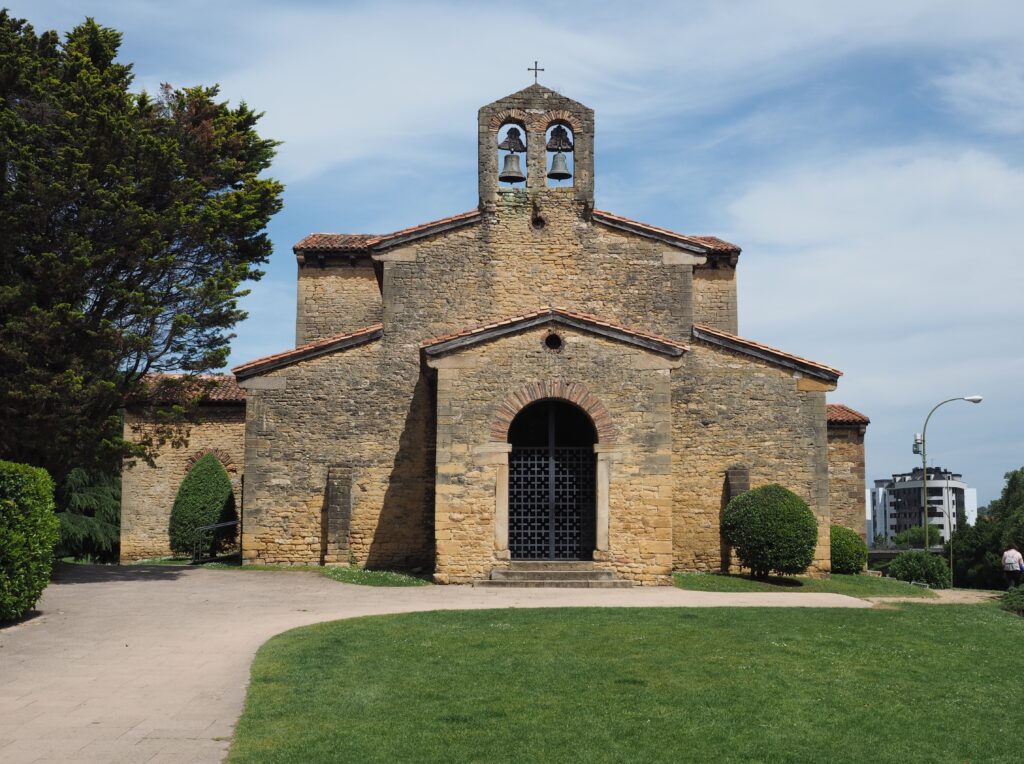The small provincial town of Oviedo in northern Spain betrays a history as central to that of Spain as anywhere in the Iberian peninsula. The conquest of Spain by the Moors in the C8 was so sudden and decisive that, within 11 years of landing at Tavira on the south coast, they had conquered all but a tiny enclave in the northern mountains. The symbolic battle at nearby Covadonga halted the Moorish advance and resulted in the establishment of the tiny Kingdom of Asturias, no more than 50k by 65k in area and totally cut off from the rest of Christian Europe. In due course, Oviedo became the centre of this isolated outpost until its replacement by Leon in 914 as the Reconquista gradually edged south.
It is difficult today to imagine the remoteness and isolation of this tiny Kingdom surrounded on all sides by Moorish Spain. The most remarkable survival of this period are three tiny churches, all constructed in the C9 and unique in their design and decoration. Remote from the influences at work elsewhere in Chrisitian Europe, they evolved their own distinctive style and form. In many ways, they symbolize the survival and rebirth of Christian Spain.
Two of the churches are located close to each other high on a hill overlooking the modern town. Santa Maria del Naranco is considered by many to be the greatest Asturian church, though never built as a church in the first place but as a palatial hunting lodge, later converted to a church. Its striking form and open porticos to each end predate later developments in church architecture. Just a few hundred yards away, is the palace chapel of San Miguel de Lillo. Assumed to be by the same architect, Tiodo, it is a radically different design – purpose built as a palace chapel but missing approximately half its original size due to landslip. It nevertheless provides a much more “complete” sense of a church than its neighbour and has an impossibly picturesque setting in a small wooded clearing.
Both can be reached by an easy 45 minute walk from the centre of Oviedo and make a pleasant day trip, take a picnic and enjoy the views over the town and hills beyond. The two chapels are extremely popular with tourists, so it is well worth trying to get there early in the morning or later on in the afternoon.

Despite the obvious attractions of these two churches, oldgreytravel’s personal favourite is the perfectly formed and complete San Julian de Los Prados, built circa 830. When constructed it would have been around 800 yards outside the old city but now it has been engulfed by the modern city with a major highway immediately adjacent. It is this rather incongruous setting that has led to the church being largely over-looked by tourists. When oldgreytravel visited, I had to knock to gain entry and was the only visitor for the duration of my visit. The attraction of Los Prados is the completeness of its floor plan and form and the remarkable survival of the extensive and beautiful murals – some of the finest in Romanesque art. The site is but a short walk from the centre of Oviedo.
Oviedo itself is now a bustling provincial capital with a fine old town of palaces and churches and an elegant new town. The entire centre is pedestrianized and provides a relaxing backdrop to the many historic buildings. There is a lively nightlife with particular emphasis on the local culture of sidrerias, spit and sawdust cider houses with an emphasis on barbecue meat. All in all, the city provides an attractive stop-over for the traveller with the added bonus of three remarkable early Romanesque churches.
Oldgreytravel travelled to Oviedo on the Feve narrow gauge railway and stayed at the good value and central Hostal Orejas.